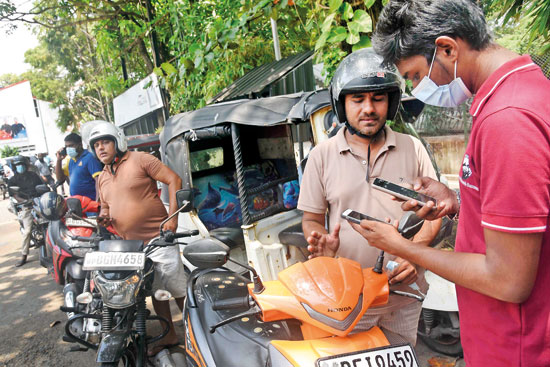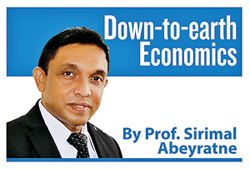“Smoke and mirrors”
View(s):In a world fraught with economic uncertainty, we must remain vigilant and take every possible step to prevent the emergence of the “next crisis.” It is in this context that I find it necessary to confront the delicate balance between illusion and truth and reflect on the forces shaping perception and policy.

File picture of fuel queues in 2020, one of the worst economic crises the country has experienced.
Weakening immunity
Let me begin by recalling a past episode of deception—one that ultimately drove the Sri Lankan economy over the edge and into its current crisis. We must recognise a hard truth: every crisis unfolds gradually, but its collapse is abrupt.
When vulnerabilities accumulate beneath the surface, they leave the economy increasingly exposed to external shocks. And when those shocks do appear, an economy that has lost its resilience is inevitably pushed to the brink.
Over the past two decades, while Sri Lanka’s economy appeared to grow steadily, it lacked the necessary fundamentals for long-term stability. Crucially, that growth was not matched by private investment and rising exports—key indicators of sustainable momentum.
Instead, the expansion was disproportionately driven by non-tradable sectors such as construction, telecommunications, government services, and public investment. This pattern of growth was heavily financed through government expenditure, underpinned by monetary expansion and foreign borrowing. Even a significant portion of foreign direct investment was funneled into these same non-tradable sectors, failing to generate long-term productive capacity.
Post-war deception
The irony is stark: private investment remained sluggish, and growth in the tradable sector was minimal. Although the economy posted moderate growth, it generated primarily rupee-denominated incomes—not the dollar earnings required to service external debt. When the time came to honour maturing foreign debt, the country lacked the foreign exchange reserves to convert rupees into dollars.
 As the COVID-19 pandemic approached, annual merchandise exports hovered around US$10–12 billion, annual foreign debt repayments alone amounted to nearly half that figure. By 2021, just prior to the suspension of external debt payments, total foreign exchange earnings—from exports, tourism, and remittances—barely reached $20 billion, just enough to meet import needs. By then, official reserves were severely depleted, leaving no buffer to manage debt obligations.
As the COVID-19 pandemic approached, annual merchandise exports hovered around US$10–12 billion, annual foreign debt repayments alone amounted to nearly half that figure. By 2021, just prior to the suspension of external debt payments, total foreign exchange earnings—from exports, tourism, and remittances—barely reached $20 billion, just enough to meet import needs. By then, official reserves were severely depleted, leaving no buffer to manage debt obligations.
The roots of this crisis can be traced back to the post-war period. This period was marked by complacency and a failure to initiate critical reforms following the end of the 30-year conflict in 2009.
Private investment, including foreign direct investment, failed to catalyse growth in tradable production and exports. Instead, the government leaned on a flawed strategy: reversing liberal economic policies and resorting to excessive borrowing to bridge the widening gap.
Unlocking growth potential
In 2024, Sri Lanka recorded a GDP growth rate of 5 per cent, followed by a 4.8 per cent expansion in the first quarter of 2025. These figures mark a welcome rebound after recording negative growth rates for one and a half years.
However, they must rise above the moderate levels in the coming years to offset the real income losses endured over the past three years. Also a higher growth momentum needs to be achieved and sustained in order to meaningfully advance toward the country’s aspiration of achieving high-income status by 2048.
These moderate gains also contrast with the IMF’s forecast, which projects Sri Lanka’s growth rate to remain as low as 3 percentage points over the next six years. Nonetheless, posting a return to positive growth following a prolonged period of crisis-driven contraction is a commendable milestone. What remains critical now is not just maintaining this momentum but accelerating and stabilising it in the years ahead.
The initial policy response to the crisis focused on restoring stability through fiscal consolidation and debt restructuring. However, these measures cannot be sustained in the medium term without robust and consistent economic growth. Fiscal consolidation, in particular, hinges on the ability to enhance tax revenues and reduce unproductive expenditures—both of which are ultimately underpinned by a growing economy.
Time after 2027
Debt sustainability should not be mistaken for the concessionary repayment terms agreed upon with creditors, nor does it imply that the government can now generate funds without resorting to further borrowing. Sri Lanka remains obligated to settle its outstanding debt over time while maintaining the ability to access credit markets.
Achieving genuine debt sustainability in the medium term hinges on robust economic growth that brings down the debt-to-GDP ratio. Without sustained growth, debt sustainability—closely tied to
economic performance—will eventually unravel.
To avert another crisis in the future, Sri Lanka must implement policies that foster strong, consistent growth. Economic crises rarely announce themselves with fanfare—they creep in quietly and gradually before erupting with a deafening crash, much like a collapse without the warning of a “Papare band.”
Ending the IMF programme
Sri Lanka’s current four-year IMF-supported Extended Fund Facility (EFF) for economic recovery is scheduled to conclude in early 2027. Once it ends, the full burden of economic policy-making will rest solely on the government’s own expertise and capabilities—but this is only part of the challenge.
The year 2028 presents a critical juncture: Sri Lanka must begin repaying all outstanding external debt, including previously stalled bilateral and commercial loans, along with their accrued interest. These repayments must be made in foreign currency—specifically US dollars—not in local currency.
This underscores the urgent need to significantly boost foreign exchange earnings from reliable and stable sources. At present, Sri Lanka’s export performance remains largely unchanged from pre-crisis levels, and consistent foreign currency inflows have yet to materialise.
While a dramatic surge in foreign exchange income may not be imminent, it is imperative to assess how the country is preparing to meet its external debt obligations. Tourism growth may offer some uplift, and remittances can help offset trade deficits—but neither is likely to provide a standalone shield against mounting financial pressures.
Hostile environment
Sri Lanka now faces an increasingly complex and volatile global economic and political landscape. While the US-brokered truce between Iran and Israel has momentarily eased tensions in West Asia, the region’s deep-rooted instability remains.
Had the conflict in West Asia escalated further, Sri Lanka would have faced significant consequences. The country’s external financial position and domestic stability could have been undermined, with severe disruptions to tea exports, oil imports, travel and tourism, and remittance inflows. Though a major confrontation appears to have been averted for now, global markets remain jittery and unpredictable.
Meanwhile, the reciprocal tariff dispute between the US and its trading partners—though momentarily sidelined—looms large. The end of the three-month grace period is near, yet attention has shifted to far more dramatic developments, including reports of “bunker buster” strikes targeting Iran’s underground nuclear facilities.
Policies and activities
Achieving and sustaining higher economic growth requires two critical pillars: increased private investment and robust export expansion. Rising GDP figures—whether moderate or impressive—should not be cause for premature celebration if they are not underpinned by genuine improvements in private investment and external trade performance.
Growth that lacks a strong foundation in these areas is unlikely to be durable. Without substantial private capital inflows or deeper integration into international markets, apparent progress may prove short-lived.
To break out of this cycle, Sri Lanka must adopt a bold and comprehensive reform agenda. Reforms must be strategically designed to restore investor confidence and position the country competitively in global markets. While ad hoc and piecemeal type initiatives may provide short-term relief, only consistent and far-reaching policy reforms will lay the groundwork for sustained, long-term growth.
(The writer is Emeritus Professor at the University of Colombo and Executive Director of the Centre for Poverty Analysis (CEPA) and can be reached at sirimal@econ.cmb.ac.lk and follow on Twitter @SirimalAshoka).
Hitad.lk has you covered with quality used or brand new cars for sale that are budget friendly yet reliable! Now is the time to sell your old ride for something more attractive to today's modern automotive market demands. Browse through our selection of affordable options now on Hitad.lk before deciding on what will work best for you!


